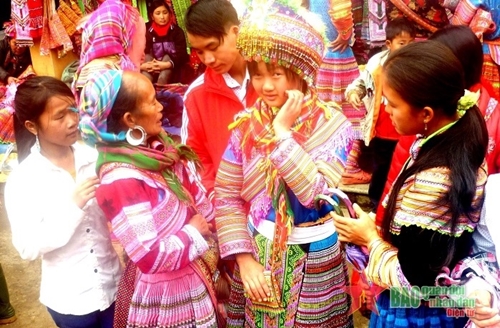However, not all information on social media truly reflects the custom and has affected its preservation and led to misunderstanding to some extent.
Beauty of the custom
Bride-kidnapping was formed and has been preserved and practiced long ago. It has in fact become a unique custom that can only be found among the Hmong minorities.
“Due to their living conditions, marriage rituals, and the custom of demanding costly wedding presents such as silver coins, buffalo, pig, chicken, wine, rice, etc., some men could not afford to get married those days,” explained Ly Chien Din, a Hmong teacher at Bao Yen 3 High School, Lao Cai province.
    |
 |
|
Hmong girls at a fair in the Northwestern region |
What’s more, a lot of families forced their daughters to marry rich men in the hope that their girls would enjoy a wealthy and easy life. It was impossible, therefore, for many couples to get married. Those Hmong couples promised to their life together, but due to self-respect the girls could not come to live with the boys before the official engagement. Therefore, the Hmong people came up with the idea of “bride kidnapping” for the troubled couples to clear difficulties and start their marriage life.
As the custom goes, when mature Hmong boys and girls attend spring festivals or fairs, they wear their newest and most beautiful outfits to not only have fun and socialize but also find the ones they love.
Hmong girls usually choose strong and kind-hearted boys good at shooting crossbows, riding horses and playing the Khen (a traditional musical instrument of the Hmong people). Hmong boys choose healthy and well-mannered girls who can do all the housework, including weaving.
After choosing the right girl, a Hmong boy carries out a “bride kidnapping” plan with his friends. When seeing the girl going to the fair or festival, the boy runs towards her and pulls her hand with the help of his friends.
The girl pretends to resist and shows fear and reluctance, sometimes even cries and asks for help from her family-members and friends, while the boy with his friends’ help tries his best to pull the girl by the hand. That whole act shows the virtues of the Hmong women.
When the girl’s family join the fight, the boy’s friends just help pulling, not fighting back. After the girl is brought to the boy’s home, she is looked after by a younger sister in the family. Half a day later, the boy’s family comes to the girl’s house with a pair of chickens and a large bottle of liquor as presents for the marriage proposal.
If the proposal is turned down, there will be no wedding. If otherwise, the two families will proceed with marriage procedures and choose a good day for the wedding in line with the tradition of the Hmong people.
Deeper understanding to preserve the practice’s beauty
According to Vang Quang Dieu, a Hmong and an official in charge of cultural affairs of Tan Duong commune, Bao Yen district, Lao Cai province, “Bride kidnapping is a traditional beauty of the Hmong people in the Northwestern region which needs to be properly understood to see its humane values.”
    |
 |
|
Students of Bao Yen 3 High School experiencing Hmong traditional practices |
In the international integration now, preservation of traditional cultural identities in combination with building a cultural life has been promoted. Bride kidnapping has been relived during festivals so that their inherent beauty can be preserved. The public should be provided with the right information to push back the wrong perception of bride kidnapping.
Therefore, in spring, schools in the region often organize extracurricular events in which Hmong students act out the bride kidnapping custom so that teachers and other students can experience its beauty.
“Experiencing bride kidnapping, we can understand the humane value of this custom,” said Ma Van Sau, a Hmong teacher at Xuan Hoa 2 Nursery School in Bao Yen district, Lao Cai province.
The bride kidnapping custom of the Hmong people is still now preserved in some localities in the Northwestern region of Vietnam, though not as much as before. The custom shows the profound humane values of the Hmong women, which is the desire for freedom in love and marriage in the olden days.
Translated by Minh Hieu - Duy Phuong - Mai Phuong - Hoai Phuong